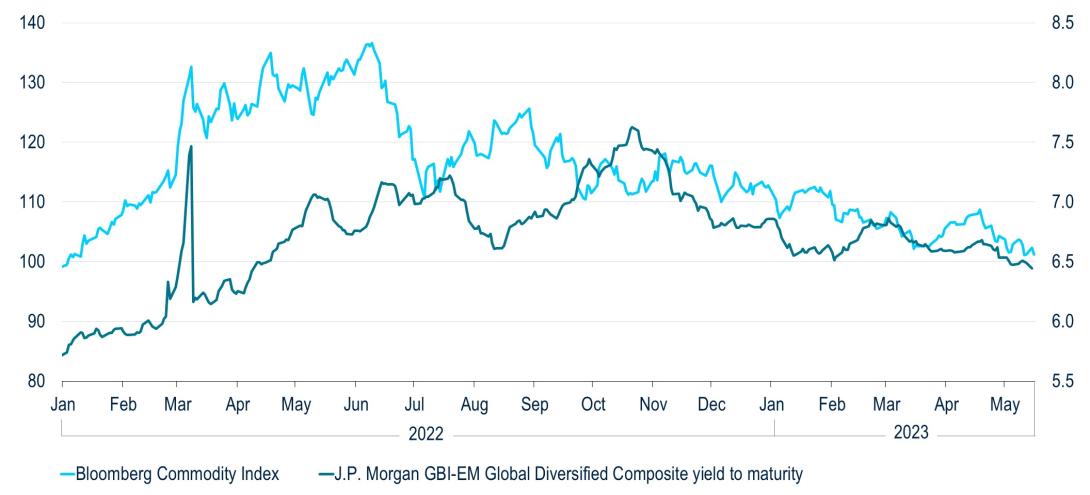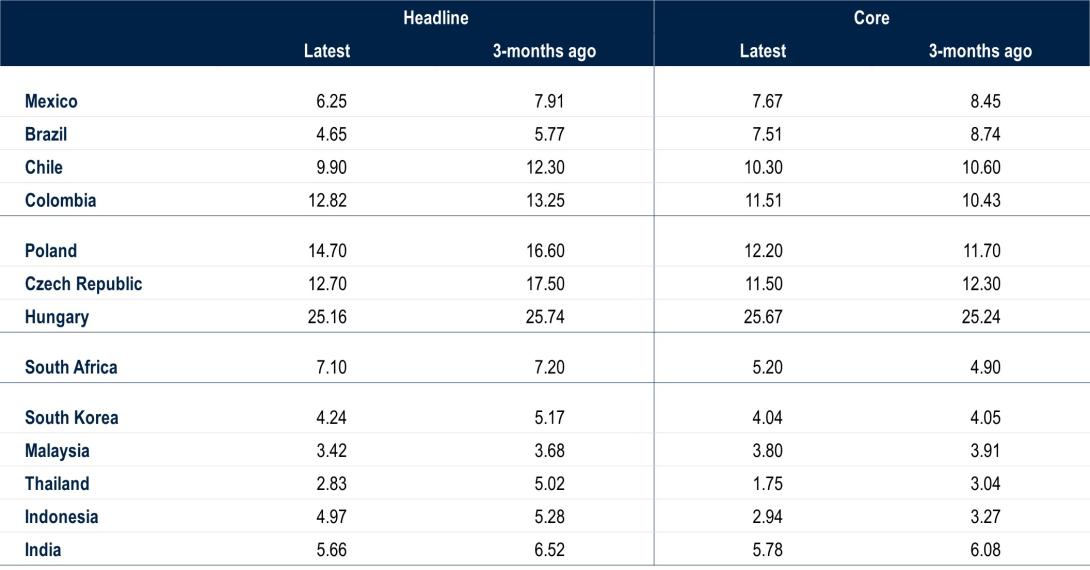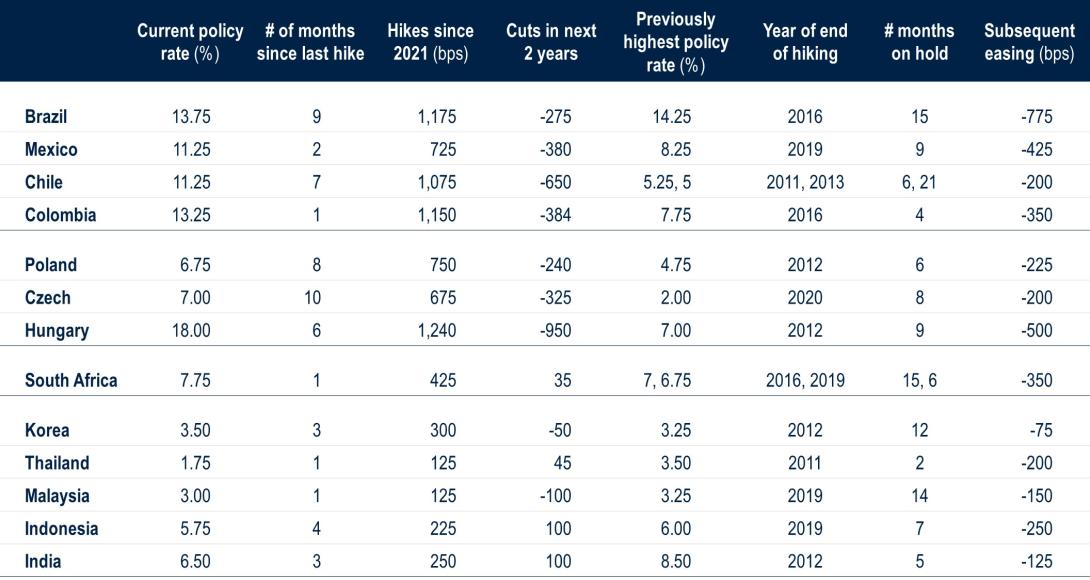EM Local Markets: from Last Hike to First Cut

As the third year of central bank tightening continues, the difficulty in identifying the peak in policy rates has emerged as one of the cycle’s prominent hallmarks. Yet, several factors point to a deceleration in emerging market inflation, placing many emerging market (EM) central banks in the area of peak rates. As markets price in central bank holding patterns and eventual rate cuts, the question shifts to the breadth of the investment opportunities in local rates markets. The following places the current transition in the context of prior, post-GFC periods of elevated policy rates as a way of assessing the momentum behind the asset class and identifying the appropriate positioning across countries.
One only needs to look at the correlation between commodity prices and the yield on the benchmark local rates index to see emerging markets’ sensitivity to commodity prices (Figure 1). As such, inflation quickly beset the emerging markets during the COVID recovery and the early stages of the war in Ukraine due to the relatively high weighting of food and energy in their inflation baskets.
Figure 1: The Correlated Moves in Commodities and EM Local Rates

Source: PGIM Fixed Income and Bloomberg.
Given the sudden onset of inflation, EM central banks led the global wave of policy tightening. In addition to the moderation in commodity prices, the benefit of their proactive approach is readily apparent as base-year effects take hold and tradable goods inflation slides while non-tradable services inflation slows at a more gradual pace. As a result, in most emerging market economies—with the exception of South Africa, Colombia, and Hungary—headline and core inflation have materially decelerated (Figure 2).
Figure 2: EM Inflation Simmers After the Boil

Source: PGIM Fixed Income.
The evolving EM inflation backdrop raises the question of where central bank policy rates are headed, when they might do so, and the respective investment implications.
Rate Cut Prospects
Following the crescendo of EM central bank rate hikes at 21 in May 2022 (Figure 3), it is not surprising that markets priced in rate cuts over the coming months through the next two years.
Figure 3: EM Central Banks' Policy Decisions (Number of central banks hiking, cutting, or keeping rates on hold, per month)

Source: PGIM Fixed Income and Macrobond.
For the EM central banks that started hiking as early as the second half of 2021 or early 2022, the timing and number of cuts that are priced in varies across countries (Figure 4). The market pricing for cuts generally depends on the starting point of the hiking cycle, the cumulative hikes thus far, as well as the dynamics around the long-term neutral policy rate. Furthermore, with 250 bps of rate cuts priced in for the U.S. Federal Reserve over the next two years, potential easing in U.S. policy could further deflate some of the strength in the U.S. dollar while alleviating downward pressure on EM currencies, thus providing another source of disinflation and policy-rate relief across emerging markets.
Figure 4: The Global Expectations for Cuts in Policy Rates
 Source: PGIM Fixed Income.
Source: PGIM Fixed Income.
The Prior, Post-GFC Hiking Cycle
Viewing the market’s expectations for rate cuts from multi-decade highs in comparison to prior, post-GFC rate cycles provides context regarding the potential time between the last hike and first rate cut as well as the total amount of easing. From a broad, historical perspective, Figure 5 shows that once the policy rate is kept at sufficiently restrictive level for an extended period, the next move is generally the start of an aggressive easing cycle.
Indeed, the table indicates that it is very common for EM central banks to keep rates elevated for six to 12 months (or even longer) before starting an easing cycle. In addition, the higher the policy rate relative to country’s long-term neutral rate and the longer central bank’s pause, the bigger the easing cycle. In most cases, the scale of monetary easing was at least 50% of the cumulative hikes.
For example, Brazil’s central bank ended its prior hiking cycle in August 2016 at the peak Selic rate of 14.25% and stayed on hold for next 21 months before cutting the Selic rate by 775 bps. Chile’s central bank was on hold for 22 months at 5% and subsequently cut its rate to 3% between 2013 and 2014. In Central Europe, Czechia, Poland, and Hungary were on hold between six to nine months before embarking an aggressive cutting cycle.1 Thailand was on hold for only two months in 2011 before cutting base rate by 200 bps to 1.5%, but South Korea kept its base rate at 3.25% for almost 12 months after hiking by 125 bps in 2010-11, and it later slashed the rate by 75 bps.
Figure 5: EM Central Bank Tightening: Now and Then

Source: PGIM Fixed Income.
When we extrapolate the historical precedent to current conditions, we find that the rate cuts priced into local yield curves have plenty of additional room to potentially adjust lower over a longer period of time, particularly as concerns about decelerating growth mount. This underscores the momentum behind the asset class as well as the rationale for long-duration positioning. The subsequent issue becomes identifying which curves may be appropriate for long-duration exposure.
Current Hiking Cycle
When shifting to the current cycle, those countries that were the earliest to tighten, the earliest to pause, or that implemented large scale rate hikes may be candidates for long-duration positioning. For example, Brazil and Czechia, both of which were early hikers in this cycle, have been on hold for more than nine months. Mexico started hiking in June 2021 and embarked on 725 bps of hikes through April 2023. Hence, the long duration positioning in these countries not only offers the potential for positive real yields as inflation pressures recede, but they also present the possibility for attractive total returns as yields drop in response to policy rate cuts.
Conversely, Colombia, South Africa, and Malaysia—relatively late and slow hikers as seen in Figure 4—recently surprised the market by hiking more than expected in April and May. As a result, optimal positioning in these countries may be more focused on underweight duration positioning at the front end of their curves. Underweight duration positioning may also apply in countries, such as Chile, where market pricing has exceeded our rate-cut expectations.
Finally, situations may warrant positioning in the intermediate portion of the curve. For instance, when compared to Latin America or Central and Eastern Europe, many Asian countries were less affected by the global surge in inflation amid China’s more moderate-than-expected reopening and lingering concerns about its real-estate sector. The disinflation spillover from China will likely influence monetary policies in the region, such as those for Indonesia and Thailand. In that context however, we still don’t expect South Korea to embark on a sizable policy easing since its central bank hiked to a post-GFC high, hence the risk-reward dynamic underscores positioning in the belly of the interest-rate swaps curve.
Conclusion
The post-COVID landscape for investing in EM local rates has been one of flexibility, and EM central banks’ leadership in tightening monetary policy initially warranted short-duration positioning at the front of yield curves. From an inflation perspective, the proactive approach to hiking rates appears to be benefitting the respective countries as inflation finally moderates across many countries. As we view the landscape for the potential scale of rate cuts, we see the opportunity for long positioning in several countries that appear to have ample room to loosen policy. Further allocation considerations include the critical role of carry and rolling down yield curves, which we’ll explore in future posts, in terms of identifying the opportunities and momentum behind the EM local rate markets.
1 Czech monetary policy has been somewhat unique. Between 2017 and 2019, the CNB hiked its repo rate from 5 bps to 2% and kept its rate on hold for eight months before hiking by 25 bps to 2.25%. The policy rate was later cut to 25 bps with few months due to COVID.
Read More From PGIM Fixed Income
The comments, opinions, and estimates contained herein are based on and/or derived from publicly available information from sources that PGIM Fixed Income believes to be reliable. We do not guarantee the accuracy of such sources or information. This outlook, which is for informational purposes only, sets forth our views as of this date. The underlying assumptions and our views are subject to change. Past performance is not a guarantee or a reliable indicator of future results.
Source(s) of data (unless otherwise noted): PGIM Fixed Income, as of May 17, 2023.
For Professional Investors only. Past performance is not a guarantee or a reliable indicator of future results and an investment could lose value. All investments involve risk, including the possible loss of capital.
PGIM Fixed Income operates primarily through PGIM, Inc., a registered investment adviser under the U.S. Investment Advisers Act of 1940, as amended, and a Prudential Financial, Inc. (“PFI”) company. Registration as a registered investment adviser does not imply a certain level or skill or training. PGIM Fixed Income is headquartered in Newark, New Jersey and also includes the following businesses globally: (i) the public fixed income unit within PGIM Limited, located in London; (ii) PGIM Netherlands B.V., located in Amsterdam; (iii) PGIM Japan Co., Ltd. (“PGIM Japan”), located in Tokyo; (iv) the public fixed income unit within PGIM (Hong Kong) Ltd. located in Hong Kong; and (v) the public fixed income unit within PGIM (Singapore) Pte. Ltd., located in Singapore (“PGIM Singapore”). PFI of the United States is not affiliated in any manner with Prudential plc, incorporated in the United Kingdom or with Prudential Assurance Company, a subsidiary of M&G plc, incorporated in the United Kingdom. Prudential, PGIM, their respective logos, and the Rock symbol are service marks of PFI and its related entities, registered in many jurisdictions worldwide.
These materials are for informational or educational purposes only. The information is not intended as investment advice and is not a recommendation about managing or investing assets. In providing these materials, PGIM is not acting as your fiduciary. PGIM Fixed Income as a general matter provides services to qualified institutions, financial intermediaries and institutional investors. Investors seeking information regarding their particular investment needs should contact their own financial professional.
These materials represent the views and opinions of the author(s) regarding the economic conditions, asset classes, securities, issuers or financial instruments referenced herein. Distribution of this information to any person other than the person to whom it was originally delivered and to such person’s advisers is unauthorized, and any reproduction of these materials, in whole or in part, or the divulgence of any of the contents hereof, without prior consent of PGIM Fixed Income is prohibited. Certain information contained herein has been obtained from sources that PGIM Fixed Income believes to be reliable as of the date presented; however, PGIM Fixed Income cannot guarantee the accuracy of such information, assure its completeness, or warrant such information will not be changed. The information contained herein is current as of the date of issuance (or such earlier date as referenced herein) and is subject to change without notice. PGIM Fixed Income has no obligation to update any or all of such information; nor do we make any express or implied warranties or representations as to the completeness or accuracy.
Any forecasts, estimates and certain information contained herein are based upon proprietary research and should not be interpreted as investment advice, as an offer or solicitation, nor as the purchase or sale of any financial instrument. Forecasts and estimates have certain inherent limitations, and unlike an actual performance record, do not reflect actual trading, liquidity constraints, fee. These materials are not intended as an offer or solicitation with respect to the purchase or sale of any security or other financial instrument or any investment management services and should not be used as the basis for any investment decision. PGIM Fixed Income and its affiliates may make investment decisions that are inconsistent with the recommendations or views expressed herein, including for proprietary accounts of PGIM Fixed Income or its affiliates.
Investing in the bond market is subject to risks, including market, interest rate, issuer, credit, inflation risk, and liquidity risk. The value of most bonds and bond strategies are impacted by changes in interest rates. Bonds and bond strategies with longer durations tend to be more sensitive and volatile than those with shorter durations; bond prices generally fall as interest rates rise, and low interest rate environments increase this risk. Reductions in bond counterparty capacity may contribute to decreased market liquidity and increased price volatility. Bond investments may be worth more or less than the original cost when redeemed. Mortgage- and asset-backed securities may be sensitive to changes in interest rates, subject to early repayment risk, and while generally supported by a government, government agency or private guarantor, there is no assurance that the guarantor will meet its obligations. High yield, lower-rated securities involve greater risk than higher-rated securities; portfolios that invest in them may be subject to greater levels of credit and liquidity risk than portfolios that do not. Investing in foreign-denominated and/or -domiciled securities may involve heightened risk due to currency fluctuations, and economic and political risks, which may be enhanced in emerging markets. Currency rates may fluctuate significantly over short periods of time and may reduce the returns of a portfolio. Commodities contain heightened risk, including market, political, regulatory and natural conditions, and may not be suitable for all investors. Diversification does not ensure against loss.
In the United Kingdom, information is issued by PGIM Limited with registered office: Grand Buildings, 1-3 Strand, Trafalgar Square, London, WC2N 5HR. PGIM Limited is authorised and regulated by the Financial Conduct Authority (“FCA”) of the United Kingdom (Firm Reference Number 193418). In the European Economic Area (“EEA”), information is issued by PGIM Netherlands B.V., an entity authorised by the Autoriteit Financiële Markten (“AFM”) in the Netherlands and operating on the basis of a European passport. In certain EEA countries, information is, where permitted, presented by PGIM Limited in reliance of provisions, exemptions or licenses available to PGIM Limited under temporary permission arrangements following the exit of the United Kingdom from the European Union. These materials are issued by PGIM Limited and/or PGIM Netherlands B.V. to persons who are professional clients as defined under the rules of the FCA and/or to persons who are professional clients as defined in the relevant local implementation of Directive 2014/65/EU (MiFID II). In certain countries in Asia-Pacific, information is presented by PGIM (Singapore) Pte. Ltd., a Singapore investment manager registered with and licensed by the Monetary Authority of Singapore. In Japan, information is presented by PGIM Japan Co. Ltd., registered investment adviser with the Japanese Financial Services Agency. In South Korea, information is presented by PGIM, Inc., which is licensed to provide discretionary investment management services directly to South Korean investors. In Hong Kong, information is provided by PGIM (Hong Kong) Limited, a regulated entity with the Securities & Futures Commission in Hong Kong to professional investors as defined in Section 1 of Part 1 of Schedule 1 (paragraph (a) to (i) of the Securities and Futures Ordinance (Cap.571). In Australia, this information is presented by PGIM (Australia) Pty Ltd (“PGIM Australia”) for the general information of its “wholesale” customers (as defined in the Corporations Act 2001). PGIM Australia is a representative of PGIM Limited, which is exempt from the requirement to hold an Australian Financial Services License under the Australian Corporations Act 2001 in respect of financial services. PGIM Limited is exempt by virtue of its regulation by the FCA (Reg: 193418) under the laws of the United Kingdom and the application of ASIC Class Order 03/1099. The laws of the United Kingdom differ from Australian laws. In Canada, pursuant to the international adviser registration exemption in National Instrument 31-103, PGIM, Inc. is informing you that: (1) PGIM, Inc. is not registered in Canada and is advising you in reliance upon an exemption from the adviser registration requirement under National Instrument 31-103; (2) PGIM, Inc.’s jurisdiction of residence is New Jersey, U.S.A.; (3) there may be difficulty enforcing legal rights against PGIM, Inc. because it is resident outside of Canada and all or substantially all of its assets may be situated outside of Canada; and (4) the name and address of the agent for service of process of PGIM, Inc. in the applicable Provinces of Canada are as follows: in Québec: Borden Ladner Gervais LLP, 1000 de La Gauchetière Street West, Suite 900 Montréal, QC H3B 5H4; in British Columbia: Borden Ladner Gervais LLP, 1200 Waterfront Centre, 200 Burrard Street, Vancouver, BC V7X 1T2; in Ontario: Borden Ladner Gervais LLP, 22 Adelaide Street West, Suite 3400, Toronto, ON M5H 4E3; in Nova Scotia: Cox & Palmer, Q.C., 1100 Purdy’s Wharf Tower One, 1959 Upper Water Street, P.O. Box 2380 - Stn Central RPO, Halifax, NS B3J 3E5; in Alberta: Borden Ladner Gervais LLP, 530 Third Avenue S.W., Calgary, AB T2P R3.
© 2023 PFI and its related entities.
2023-4073
Sign Up Now for Full Access to Articles and Podcasts!
Unlock full access to our vast content library by registering as an institutional investor .
Create an accountAlready have an account ? Sign in
